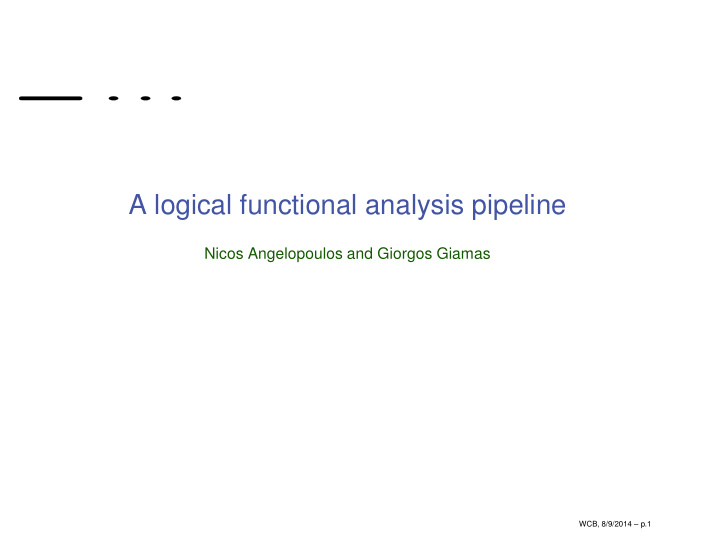



A logical functional analysis pipeline Nicos Angelopoulos and Giorgos Giamas WCB, 8/9/2014 – p.1
. . . introduction . . . it is becoming increasingly clear, that the ability to reason at the highest possible level with the available data has a profound effect on the kind of questions scientists can address. It is indeed the view of experimental data as knowledge which is becoming an important realisation among the scientists in the biological sciences. Traditionally, data analysis has been viewed as an independent exercise it is increasingly becoming apparent though, that data analysis is now taking a more central role with important high-impact papers focusing on evaluating results rather than producing unique datasets. WCB, 8/9/2014 – p.2
why Prolog? Clear computational paradigm Knowledge representation and reasoning Robustness Memory management Program and data duality High level of abstraction Calling R functions Indexing Database interactions Operating systems support WCB, 8/9/2014 – p.3
what is lacking ? Lack of programmers Language development and stability Critical mass Performance WCB, 8/9/2014 – p.4
Real - Integrative statistics with R Run R functions on Prolog data. Reductionist design ? − x ← mean ([1 , 2 , 3]) . ? − X ← x. X = 2 . 0 ? − y ← [1 , 2 , 3] , x ← mean ( y ) . WCB, 8/9/2014 – p.5
Tyrosine Kinase knockouts Important molecules in signalling. 65 knock outs WCB, 8/9/2014 – p.6
dysregulation patterns 6 SYPL1 MUC5B FTH1 BTF3 5 TCOF1 ERGIC1 FTL CEACAM5 SQRDL 4 S100P RHPN2 QSOX1 CAMSAP2 3 MUC5AC HUWE1 MAP7 NCOR1 2 PES1 AKR1A1 FHOD1 PXDN DCXR 1 MAP7 NEDD8 UBTF RCN2 0 SUPT16H SSRP1 PHF3 ASMTL DCAF8 H1F0 POLR1A BAG6 PNN IVD OXSR1 ASNS PIK3C2B ADH5 RABL6 HEATR1 AGRN LIMA1 MROH1 PREX1 ASS1 ITGB4 GALNT7 COBLL1 PLCB3 731788 NEDD4 UACA PSME3 ITGB4 ARMCX3 ANO6 ACTN1 BOP1 SCIN ABCA2 PYGM EPB41L1 SLC38A2 GYS1 SCARB1 CELSR2 ACTN4 ZNF185 WDR26 JAK1 PGR TMEM164 SQSTM1 AGL AKR1C2 CD44 CA12 WCB, 8/9/2014 – p.7 ABL2 BTK CSF1R CSK DDR1 EPHA3 EPHA6 EPHA7 EPHB2 EPHB6 ERBB3 FES FGFR1 FLT3 FYN
clusters based on dysregulation PDGFRB EPHA1 MERTK H C 6 MET EGFR K IGF1R N C R T T K S NTRK1 P R INSR EPHB1 K L 3 M EPHB4 MST1R T K 2 K R 2 RYK R F EPHA2 F G F FLT1 ABL1 TYRO3 AXL ROR2 EPHA4 ZAP70 EPHB3 K T A M ERBB2 ERBB4 CSF1R LMTK3 ABL2 PTK2B EPHA6 N T R K 2 BTK RET FGFR1 PTK7 EPHB2 TEC ERBB3 SYK EPHA7 T N CSK K R 1 DDR1 O R JAK2 1 3 T KDR L EPHA3 F YES1 N TYK2 Y EPHB6 LCK F FES J LYN PTK2 1 T A K N K Y K 1 T 2 S WCB, 8/9/2014 – p.8
cluster populations 15 10 Cluster 1 2 3 Members 4 5 6 7 8 9 10 5 0 1 2 3 4 5 6 7 8 9 10 Clusters WCB, 8/9/2014 – p.9
level 2 GO biological process 1 2 Cell communication 3 4 5 Cell cycle 6 7 8 Reproduction 9 10 Metabolic process Transport Immune system Growth Development Cellular process Cellular component organization Apoptosis Biological regulation Cell adhesion WCB, 8/9/2014 – p.10 0 20 40 60 80
4-carbohydrate metabolic process ARFGEF1 DOLPP1 GBA GLYR1 GNS HK1 ISYNA1 NFKB1 PHKA1 PAPSS2 PGM3 RAE1 SEC24A SLC3A2 SDC1 MUC5B PGK1 CD44 AGRN GALNT6 PDHB PCK2 PC PFKL GPD2 OGDH IDH3A UGP2 DLAT GPI ENO1 GALK1 GO:0005975, carbohydrate metabolic process. pval:6.531864e-5 count: 32 size: 804. WCB, 8/9/2014 – p.11
doxorubicin 3 Confers MCF7 resistance sensitivity 2 DU4475 Clusters3 1 0 7 CAL51 0 Clusters2 − 1 0 CAL148 2 3 − 2 7 HCC38 8 − 3 CAL851 Clusters 1 3 HCC2157 4 5 6 HCC1599 7 8 HCC1806 Effect resistant sensitive MDAMB468 IC_50 2.35 MDAMB134VI − 4.45 BT20 HS578T HCC70 EVSAT UACC812 MDAMB453 MDAMB415 HCC1395 HCC1143 PACSIN2 RNF213 TOM1 PITPNB AHNAK CAPZB BLVRB GOLGA3 H2AFX HIST1H4A ACAA2 PRCC KPNA2 MYH10 RCN2 WCB, 8/9/2014 – p.12
knockout effects on TKs Color Key and Histogram 3000 Count 2000 1000 0 0 0.5 1 1.5 Value ABL1 ABL2 AXL BTK CSF1R CSK DDR1 EGFR EPHA1 EPHA2 EPHA3 EPHA4 EPHA6 EPHA7 EPHB1 EPHB2 EPHB3 EPHB4 EPHB6 ERBB2 ERBB3 ERBB4 FES FGFR1 FGFR2 FLT1 FLT3 FRK FYN HCK IGF1R INSR JAK1 JAK2 KDR LCK LMTK2 LMTK3 LYN MATK MERTK MET MST1R NTRK1 NTRK2 NTRK3 PDGFRB PTK2 PTK2B PTK6 PTK7 RET ROR1 ROR2 RYK SRC STYK1 SYK TEC TNK1 TNK2 TYK2 TYRO3 YES1 ZAP70 ABL1 ABL2 AXL BTK CSF1R CSK DDR1 EGFR EPHA1 EPHA2 EPHA3 EPHA4 EPHA6 EPHA7 EPHB1 EPHB2 EPHB3 EPHB4 EPHB6 ERBB2 ERBB3 ERBB4 FES FGFR1 FGFR2 FLT1 FLT3 FRK FYN HCK IGF1R INSR JAK1 JAK2 KDR LCK LMTK2 LMTK3 LYN MATK MERTK MET MST1R NTRK1 NTRK2 NTRK3 PDGFRB PTK2 PTK2B PTK6 PTK7 RET ROR1 ROR2 RYK SRC STYK1 SYK TEC TNK1 TNK2 TYK2 TYRO3 YES1 ZAP70 WCB, 8/9/2014 – p.13
software db_facts 44 / 19 db-tables-as-facts & SQL layer proSQLite 109 / 33 SQLite interface pubmed 14 / 3 Access pubmed publication records Real 68 / 11 Integrative statistics with R mtx working with matrices go_string GO term STRING graphs map_id mapping across nomenclatures func functional analysis pipeline WCB, 8/9/2014 – p.14
Recommend
More recommend